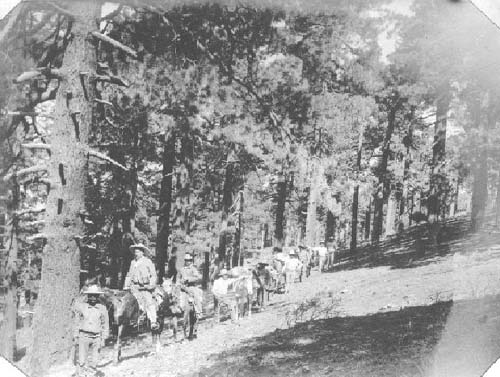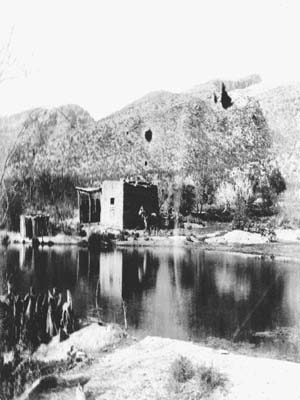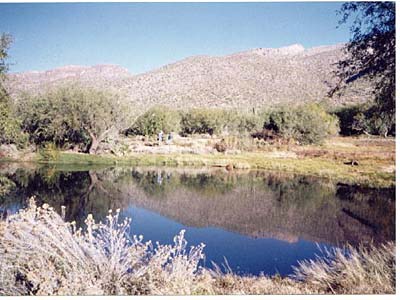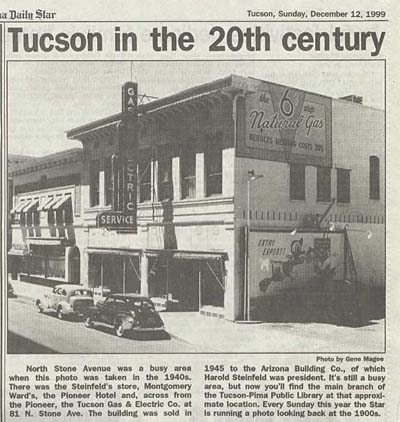







|
|
The Messenger
Edited by Joyce Coon
|

|
May 28, 2000
MUSEUM MESSENGER MARCH 2000 VOL. 6 NO. 1
From the December 1, 1997 Tucson Citizen by Paul L. Allen, Staff Writer.
"Turn-of-the-century treasures unburied: Prowling through dusty archives
of yellowed documents and hard-to-read microfilm of old newspapers wouldn't
be half as much fun if not for the occasional "treasure" unearthed.
Dr. James B. Klein, a local surgeon and zealous history sleuth, recently
discovered a trove of photographs--images of people and places in the
Santa Catalina Mountains--that have been buried in federal files for
nearly a century.
Klein, president of the Otis H. Chidester Scout Museum of southern Arizona,
discovered photographs by chance while researching the early history
of the Boy Scouts in southern Arizona.
Chidester, a Tucsonan who died in February 1997, at age 93, was believed
to have been the nation's senior Scout, having joined the organization
Sept. 8, 1912. One of Chidester's projects was to compile the history
of the Catalina Council of Boy scouts of America.
The Boy Scouts of America officially became an organization Feb. 8,
1910, but Klein said "unofficial" scouting groups were formed in the
United States before that. Few records of the very early history of
scouting here exist, he said. An avid history buff, Klein offered to
investigate those early years by perusing old newspaper microfilm. While
doing so, he found references to the preparations for establishing a
national forest reserve in the Santa Catalinas--now known as the Coronado
National Forest.
The forest is used extensively by today's Scouts, so Klein decided to
include that piece of history in his scouting research. "I finally found
something in both newspapers on July 17, 1902. They talked about this
(a forest reserve) being a good thing, and there was a reference to
special timber agent S.J. Holsinger who had been laboring along these
lines for several years."
Curiosity piqued, Klein embarked on a six-month effort to track down
information about Samuel J. Holsinger.

"Samuel J. Holsinger leads his 13-man crew along Gibbon's Trail on Soldier's
Mountain at the turn of the century near what is now Palisades Ranger
Station. The crew was fighting fires and exploring the Catalinas to
determine their value as a national forest."
"Samuel J. Holsinger was a special agent for the Gneral Land Office
of the Department of Interior," said Klein. His assignment was to access
the suitability of the forest covering Mount Lemmon for designation
as a federal reserve. "I spent a lot of time on the telephone". He discovered
that Holsinger had filed his report to the government on March 20, 1901.
The report formed the basis for the Dept. of Interior recommendation
to President Theodore Roosevelt that the forest reserve be estalished.
Roosevelt signed the proclamation July 2, 1902.
Dr. Klein asked for a copy of the proclamation and later received the
report and photographs. The 23 photos were taken during this time period
while Holsinger and his team were surveying. There are images of Gibbon's
Spring (now the pond on the12th hole at Raven Golf Club at Sabino Springs),
Soldier's Mountain near Palisades Ranger Station, and others.

Gibbon's Spring as it was in 1901. Below: Today it's the pond on the
12th hole of Tucson Raven Golf Club at Sabino Springs. (Photo courtesy
of Dr. Art Janssen)

Taken from the Arizona Daily Star August 3, 1929
BIGGEST SCOUT GIVEN BARONY
Arrowe Park, England, Aug 2: "Fifty thousand boyish voices cheering
in all languages roared welcome today to the Prince of Wales, accompanied
by Ambassador Charles G. Dawes in the royal box at the world Boy Scout
jamboree here. It was a great day for the Scout troops and particularly
exciting for the American youngsters whose camp was inspected by the
heir to the British throne. Ambassador Dawes made an informal surprise
visit this afternoon. Then followed the night singsong around campfires
dotting the 450 acre park and so to bed, tired but happy. But not until
the prince, Ambassador Dawes, and world Scout leaders witnessed a march
of the world pageant of youth encamped here.
The prince read a message to the assembled troop from his father, King
George, who asked the boys to remember it is chiefly upon coming generations
the future peace of the world depends.
When the heir to the throne announced the barony granted by the King
to their founder, Sir Robert Baden-Powell, cheers were raised. Sir Robert,
speaking in acknowledgement, assured his young followers the only reason
he got the title was that the King could not make every Boy Scout a
baron, so he picked on the chief through whom to honor all in the great
crusade of youth and peace.
John McInerney, 13 year old Rochester, NY youth, received special attention
from the prince, for Walter Hagen had told Wales in advance that young
McInerney showed great promise as a golfer. "Keep you eye on the ball,
your head still and you may go as far as Hagen," was the substance of
the prince's advice as he shook hands with the American.
Ambassador Dawes was accompanied by his son Dana, who is a Star Scout.
It was a great day for the Scout troops and particularly exciting for
the 1300 American youngsters whose camp was inspected by Mortimer Schiff,
American scout leader who yesterday donated 50,000 pounds to the British
Scout movement.

Photo by Gene Magee
"North Stone Avenue was a busy area when this photo was taken in the
1940s. There was the Steinfeld's store, Montgomery Ward's, the Pioneer
Hotel and, across from the Pioneer, the Tucson Gas & Electric Co. at
81 N. Stone Ave. The building was sold in 1945 to the Arizona Building
Co., of which Harold Steinfeld was president. It's still a busy area,
but now you'll find the main branch of the Tucson-Pima Public Library
at that approximate location."
Taken from the Airzona Daily Star, December 12, 1999 and quoting from
a note to Dr. James Klein from Col. Alan B. Thomas (a Museum member):
"The photo...shows a downtown location you know about but may have never
seen.
The buildings shown are directly across the street from the old Pioneer
Hotel. North Stone Avenue runs across the bottom of the photo and the
intersection with Pennington is just at the left border. Of interest
to you will be the arched entrance at the center of the buildings. It
opened onto a flight of stairs that led to a second floor landing, to
the left. The shaded windows in the photo were on that office.
It was from the curbing by the stairwell that Scouts going to Camp Lawton
would congregate on a Saturday morning. They would load themselves and
all their gear onto a Chevrolet stake body truck. There were no seats
or seatbelts in those days. Then it was about a three or four hour drive
up a narrow two lane Oracle Road, and then up the narrower yet and hazardous
north side "controlled" road to Mt. Lemmon and Camp Lawton. I had the
pleasure and responsibility of driving that truck on that trip and others
on many occasions before and after WWII."
(Thank you Col. Thomas for sharing)
Activities at the Museum
Tremendous progress has been made over the summer and fall of 1999.
We have added and/or repaired nine display cases which house memorabilia
dating back to 1910, installed five book shelves, four in the library
that hold Scouting manuals, fiction and nonfiction books, Order of the
Arrow, etc. The one in the Reference room holds Catalina Council history,
Jamboree memorabilia, oral interviews, Lone Scout books, Woodbadge information,
and more.
Our Cub display is shaping up. We welcome any donations you may have
pertaining to Cub Scouting, and are receptive to any type of Scout memorabilia
you might be willing to donate. We are very proud of our new look and
invite you to visit us soon.
A MESSAGE (Thank you Chuck Moyer)
The following is a Eulogy written by A.C. “Chuck” Moyer, II, Scoutmaster
of Troop 392, Tucson, Arizona, and was offered as a Scoutmaster’s Minute,
February 6, 1997. Mr. John H. Wolf, passed away January 28, 1997, was
buried February 1, 1997, in York, Pennsylvania. He had been a Cubmaster/Webelos
Leader Pack 65, Scoutmaster Troop 65, District Committee Member of York-Adams
Area Council, BSA, and a Silver Beaver recipient. Chuck Moyer, who offered
this Eulogy on February 6, 1997, received his Silver Beaver from the
Catalina Council, BSA, on February 7, 1997. Chuck is a member of our
Museum.
We quote: “We often hear talk of proper role model’s for the youth of
today. Some feel that the gifted and talented professional athletes
are fitting role models. Others see TV or movie personalities that fit
that position.; while others might see prominent local, state or national
political leaders as the standard bearer.
As we walk the shopping malls, or maybe the local school halls or just
even out in our own neighborhoods, we will see many young people emulating
some of their role model’s by wearing the team colors of that particular
individual. Even going to the extent of having the playing number and
name of those persons posted on their shirts. While on occasion they
will have to change the colors of their jerseys because that individual
sought out another team that was willing to pay a higher dollar amount
for their role model’s services.
Well, I guess you might say that I was the same way when I was considerably
younger. Or you might say that I was in on the beginning of the current
fashion trend, because I too, fell prey to emulating a particular role
model of mine by wearing the team colors, and to this day I still am
seen supporting those colors. My only problem is that I had to acquire
larger shirts as I physically grew in stature and size, as evident today!
You see it has been a great number of years that I had this one particular
role model, and fortunately he never plied his trade to a higher paying
owner. In fact, this person was paid on a different wage scale.
To him a simple “Thank you!” seemed to be enough. Or maybe it was the
joy of a smile, or a laugh from a youth having fun, emulating his ways
or following his instructions.
You see, today I feel a great loss with the passing of one of my great
role models, Mr. John H. Wolf, my Scoutmaster.
I’ll probably still continue to wear the colors of my role model as
I have for over 41 years, and when my time comes to gather at that Great
Scout Campfire in Heaven, I hope to meet up with Mr. John Wolf and those
other adult scout leaders who have so aptly served as Scouting role
models for me and the other guys from my neighborhood.
You see, as adult leaders you just never know the extent of the influence
you have on the youth of your charge. It goes on well after that troop
meeting or that hike or campout. It goes on well after that boy has
left the Scout program.”
(Editor note: What a wonderful tribute to Mr. Wolf, and how timely as
Otis passed away on February 22, 1997.)
BOARD OF DIRECTORS
Curator Maury Guptill
President Dr. James Klein
Vice President William H. White, Jr.
Treasurer Dr. James Gruhl
Secretary Gowher Jamshedi
Directors Joyce Coon
William Garbell
Luis Romero
Todd Scholer
Articles, memorabilia, address changes, corrections or additions are
most welcomed. Please contact us.
Museum Messenger 6.1 March, 2000
This is the quarterly publication of the Chidester Scout Museum, a non-profit
organization founded in 1984 and incorporated under the laws of the
state of Arizona. Articles may be submitted by e-mail to Joyce Coon,
editor, at BJCoonTuc@aol.com
or to the Museum’s address: Otis H. Chidester Scout Museum of Southern
Arizona, Inc., 1937 E. Blacklidge, Tucson AZ 85719.
We preserve the memories of Scouting
|